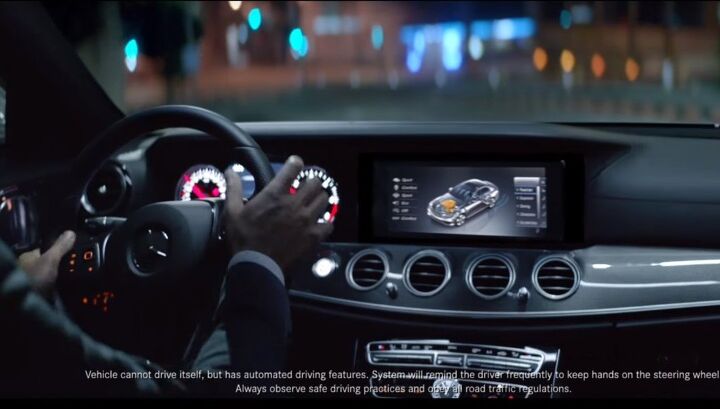Mercedes-Benz Slammed Over Misleading Commercial

A glitzy Mercedes-Benz commercial that touts the 2017 E-Class as a vehicle that “can drive itself” has consumer and safety advocates fighting mad.
A number of groups are calling on the Federal Trade Commission to take action against the automaker, saying Mercedes mislead the public. In a letter to FTC chairwoman Edith Ramirez, the groups claim the E-Class doesn’t come close to being a self-driving vehicle, and fine print doesn’t cut it.
The ad showcases the new Benz’s automated features. In it, an E-Class driver briefly taking his hands off the wheel during a nighttime drive, then uses the vehicle’s self-parking system. “Is the world truly ready for a vehicle that can drive itself?” the narrator states. “An autonomous-thinking automobile that protects those inside and outside. Ready or not, the future is here.”
2017 E-Class models are available with “Drive Pilot,” an automated system that uses adaptive cruise control and a lane-holding feature to make driving easier.
The letter bears the signatures of Consumer Reports, the Center for Auto Safety, the Consumer Federation of America, and Joan Claybrook, former National Highway Traffic Safety Administration administrator. In it, the groups say the automaker’s claim could give drivers “a false sense of security in the ability of the car to operate autonomously.”
Fine print appears at the bottom of the ad, warning consumers that the vehicle “cannot drive itself, but has automated driving features.” Still, Mercedes-Benz is telling consumers two very different things, the groups say.
“The E-Class does not meet the definition of either a fully or partially self-driving car, yet it is marketed in a way that a reasonable consumer would believe it does,” the letter reads, adding that the commercial could pose a safety risk.
Daimler’s advert lands at a stormy time for autonomous driving. Controversy spiked after a fatal May crash involving a Tesla driving in semi-autonomous Autopilot mode. The NHTSA and National Transportation Safety Board opened investigations into the crash, focusing on what role Autopilot played.
A Mercedes spokesperson quoted by Automotive News said the company didn’t intend to cause confusion. The spokesperson added that the technologies featured in the commercial are clearly identified as “driver assistance systems.”

More by Steph Willems
Latest Car Reviews
Read moreLatest Product Reviews
Read moreRecent Comments
- MaintenanceCosts Nice car if you can get it properly sorted, but the level of safety tech doesn't seem quite enough for a young driver on today's brodozer-infested highways.
- VoGhost OK. But if Subaru really wants this to sell, they'd make it as a PHEV with enough American content to get buyers $7,500 back on their federal taxes. Otherwise, this really doesn't stand out in a world of RAV4s and CR-Vs.
- VoGhost Tesla has an average of 28 days of inventory, less than half industry average.
- FreedMike Ah, Chesterfield Mall...my old teenage stomping grounds. Bummer what happened to it, that's for sure. But that's what happens when the city council approves not one, but two "premium" outlet malls right down the road to be built. That killed this mall dead.And in case anyone's interested...yes, Teslas and other EVs are very popular in that neighborhood.
- MaintenanceCosts Subarus can be durable, but they are going to demand more frequent and expensive regular maintenance than your typical Honda or Toyota. I suspect for a lot of third and fourth owners that means the economic equation favors scrapping them a bit earlier.


































Comments
Join the conversation
if people really are demanding transport in which they can sit rather than use their legs, yet don't need to be an active participant, isn't that a mandate for public transport? Not big busses and multi-unit light rail that arrives/departs every 30 minutes as is seen now, rather small single units that stop at your stop every 10 minutes. the local interstate is a traffic jam every morning with people going from one general area to another general area. Why not have large express busses or light rail connecting those general areas, and small (8-10 passenger) local frequent busses feeding those large transporters? Happens every day along the east coast....
Here's an idea. Mercedes should call it Autopilot :-)